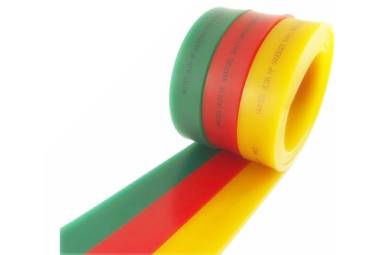What Are the Functions of the Squeegee in Screen Printing?
Apr. 17, 2020
Screen printing is composed of five major elements: screen printing plate, doctor blade, screen printing ink, and screen printing machine substrate. Screen printing belongs to stencil printing among the four major printing methods. Squeegee is another important printing material in screen printing. It is very important for the screen printer to understand the characteristics of squeegee and its application in screen printing. The silkscreen printing mesh supplier will introduce the main functions of the squeegee.
Screen printing machine on the scraping knife made of silicone rubber, manual printing more use of natural rubber and synthetic rubber and polyurethane rubber and other materials made. There are four main types of PU squeegees from all the printing equipment. This includes a vertical steel blade (with a square edge without a tip), a pointed scraping blade (with rounded edges), a bevel scraping blade and a thin scraping blade.

Polyurethane Squeegees
1. The polyurethane squeegees in screen printing have the following features:
The first is to be able to scrape the ink to the screen on the pattern of the open part and make the screen and substrate contact. Therefore, the scraper must be strong enough to avoid bending due to screen tension and contact breakage.
Secondly, the scraper must adapt to the surface of the substrate of any concave and convex, as well as the printing platform may exist on the uneven surface. Therefore, the scraper must be flexible, able to bend, so that it and substrate close contact.
Third, the scraping board must have a sharp edge, in order to cut off and clean the image part of the ink. Therefore, the scraper should be good solvent resistance and wear resistance. Based on this, polyurethane vinegar has become a commonly used material for scraping boards.
Namely, the main role of the squeegee is to squeeze the ink through the screen printing plate and transfer it to the substrate, the performance of the squeegee has a direct impact on the final printing effect, so understand the performance of the squeegee parameters can provide a basis for us to choose the right squeegee.
2. Performance parameters of the scraping knife
From the mechanical point of view, the performance index of squeegee is mainly hardness and abrasion resistance.
2.1 the hardness
Hardness refers to the hardness and elasticity of the squeegee:
(1) hardness refers to the degree of squeegees under pressure deformation, generally expressed by shore hardness value, the higher the value, the greater the hardness, on the contrary, the smaller the hardness.Small hardness is conducive to the scraping knife and screen contact, has a good effect on filling ink, but so its bending resistance is poor, easy to make the scraping knife and screen printing plate Angle changes, affecting the stability of the printing quality; Hardness is large, scraping knife bending resistance is good, but the contact with the screen is poor, not conducive to fill ink, and printing on the screen friction is also large, make the screen wear, sometimes will affect the printing accuracy.
(2) elasticity due to the squeegee itself material in the squeegee will be under a certain amount of pressure and produce a certain amount of bending, therefore, considering the squeegee bending fatigue and mechanical strength problems, require the squeegee has a certain amount of elasticity.
For the hardness of scraping knife material, it usually can be divided into soft, medium, hard three blades. Especially soft blade hardness is 45~50, especially hard blade hardness is 75~90, generally choose 60~80 is better. Such as printing accuracy and quality requirements of higher color screen printing, used scraping knife hardness of 70. According to the characteristics of good contact between soft and hard materials, in printing, if it is soft material (such as paper, plastic film, etc.) or more smooth substrate, you can choose a harder scraping knife; And if hard material (such as glass, metal, etc.) or relatively rough substrate, choose the hardness of the smaller scraping knife.
2.2 wear resistance
The physical properties are mainly used to measure the life of the scraping knife. As the scraping knife and screen printing plate are in direct contact, each time there is friction (in screen printing up to ten thousand times), so the requirements of the scraping knife wear resistance is good and has a certain mechanical strength. In addition, the scraping knife had better have a certain degree of lubricity, so the scraping can reduce friction as far as possible, enhance its wear resistance to extend the life of the scraping knife.
As the main material of the scraping knife is rubber and all kinds of rubber materials to the solvent (printing ink) affinity is different, so the scraping knife in contact with ink or solvent after its performance will have a certain change, the most common is the hardness of the scraping knife and volume change, after the use of a period of time scraping knife volume expansion deformation. The distortion of the volume reduces the edge precision of the scraping knife, and the uneven ink leakage will affect the print quality. Generally speaking, the hardness of high rubber crosslinking density, chemical resistance is strong, the coefficient of expansion is relatively small, so in the selection of scraping knife, in the premise of meeting the printing requirements, as far as possible to choose a higher hardness of rubber scraping knife.
The scraper is an important screen printing material, its structure is simple, but its role can not be ignored. In printing, the scraping knife material, structure, mechanical properties have an impact on the quality of screen printing.







